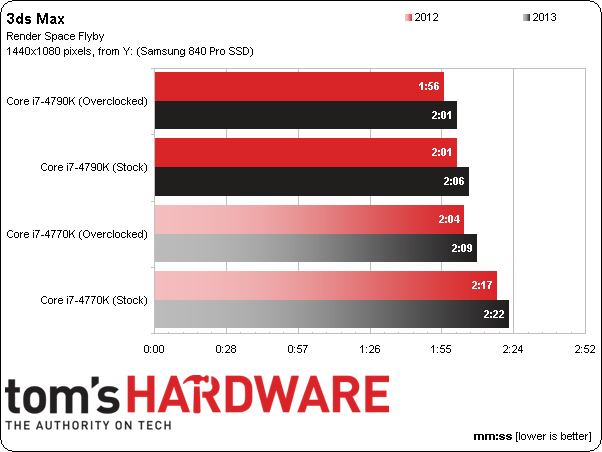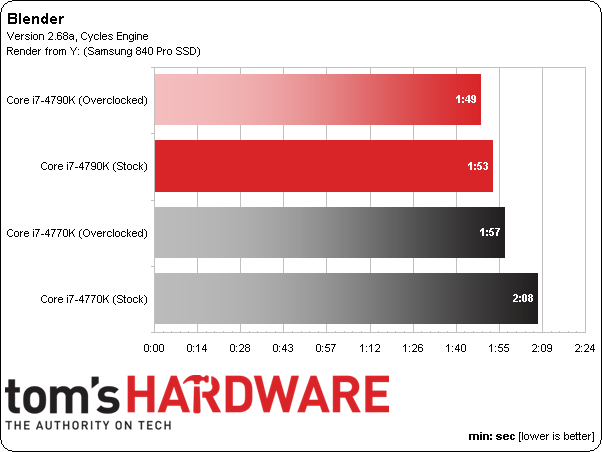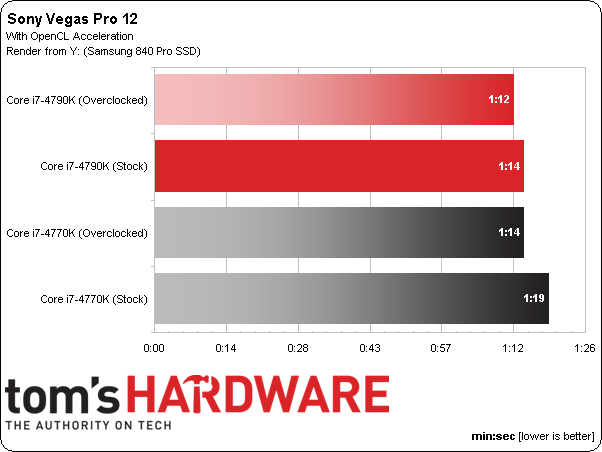Core i7-4790K Review: Devil's Canyon Tantalizes Enthusiasts
Despite a clear performance advantage, Intel just doesn't seem like an enthusiast-friendly company. Certain elements in the organization want to change that perception, though. Devil's Canyon is meant to allay power users with more speed.
Results: Content Creation
It's difficult to get a sense of scale from four comparison points. However, if we were to add, say, AMD's Kaveri-based A10-7850K to the chart, you'd see a workload completion time in 3ds Max 2012 of 3:46. That's 1:45 longer than a stock Core i7-4790K. In the context of our battle between Haswell-based processors, though, the biggest benefit again comes from overclocking the stock Core i7-4770K. Of course, a stock 4790K is just a bit quicker, and applying some extra clock rate to the new CPU helps even more.
For the sake of comparison, a Core i7-4790K, overclocked, is almost as fast as a Core i7-3930K at its default clock rate in this well-threaded application.
Expect steady improvements as you step from Core i7-4770K at its factory frequencies to the same CPU overclocked to a Core i7-4790K. Blender easily taxes all four cores on both processors, so the overclocked chips are operating at 4.2 and 4.4 GHz, respectively.
Vegas Pro 12 is set up to exploit our GeForce GTX Titan through OpenCL. Despite the fact that we're offloading some of the host processing workload, CPU performance does still matter, as only some of the rendering process is accelerated.
Get Tom's Hardware's best news and in-depth reviews, straight to your inbox.
-
NBSN Really nice read. I am very excited to see how well the i7-4790k performed, and that means in 2-3 years the CPUs that will be out are going to be amazing. It will be nice to start seeing stock clocked 4 GHz to 4.5 GHz Intel CPUs to better keep up with the AMD overclocking that many builders do. I prefer Intel and really feel that they offer the best performance for their CPUs.Reply
I built my PC at the end of last year, beginning of this one and went with a i7-4930k. I really wanted a six core processor and have not been disappointed. I have been itching to build another PC because it was really fun to put the plan of components together and although my hands were to big and my medical conditions prevented me from getting to do a lot of the building, my wife helped a lot with that part and it was nice to see the finished product in action. With that being said, I don't have a lot of money for anything right now and hope that my disability pay finally comes through so I can start picking together parts for a computer for my wife. She won't need anything as powerful as I have, and the i7-4790k sounds pretty sweet. -
BoredErica The average overclock based upon my Google Doc of about 185 overclocks now averages at 4.55ghz for Haswell. A tim change isn't going to gain an extra 200mhz and even then, it's being generous.Reply
On a side note, this website annoys me. I click to add comment and the default fields are for signing up, no logging in, and when I do, I am back to the homepage. Great. -
roymustang It would've been nice to show benchmarks and temps vs sandy bridge (2600K) at same frequency to help us gauge the progress (or the lack of) that's been made in the last three and a half years.Reply -
neon neophyte so one of their biggest selling points ended up resulting in a 6 degree difference.Reply
bring back solder intel. -
Amdlova nice improve :) please where i put my razor? no way 6ºc improve. my ambient temp hits 45ºc my old 3770k 4.6ghz hit 88ºc on core. with this "new shinning old tech" i can't hit the 4.2ghz. intel miss and miss Hard!Reply -
NBSN I think that the whole real point of releasing this new processor and the others to follow it is simple. Intel wants to offer a better stock clock for those that do not want to or do not know how to overclock their processor. And since AMD allows easier overclocking, or at least a whole lot more processors that can be overclocked than the ones that Intel specifies for their own products. This will help a lot of consumers decide Intel over AMD if they continue to offer comparative clocks.Reply -
ssdpro First problem: 6C between the old and new TIM is something, but not much. As one of the big improvement features, that is disappointing.Reply
Second problem: Why is Tom's using 1.275 V for 4200MHz on both units? Is that actually 1.275v with LLC disabled or is LLC on a setting resulting in the lowest load voltage? If one of those units need 1.275v to be stable at 4200 you have a real donkey sample on your hands. Even the worst i7-4770k are stable at 1.20v @ 4200. Or was the over voltage designed to test an unrealistic incompetent situation to either emphasize or DE-emphasize the TIM difference? -
Adroid Sorry, but I'm entirely unimpressed. Improved TIM is a waste of time. I thought this was going to release with fluxless solder. 6° worth the wait ? 6° is the difference between air cooling and water cooling.Reply
Voltage wall is still at the approximate same place. Heat is still the limiting factor. I expect some of the better binned 4670K will hit equal or better than the 4690K.
I'll stay with my 3570K @ 4.3ghz - this clearly isn't much of a step up. Looks like I'm waiting for a DDR4 system in a couple years.



